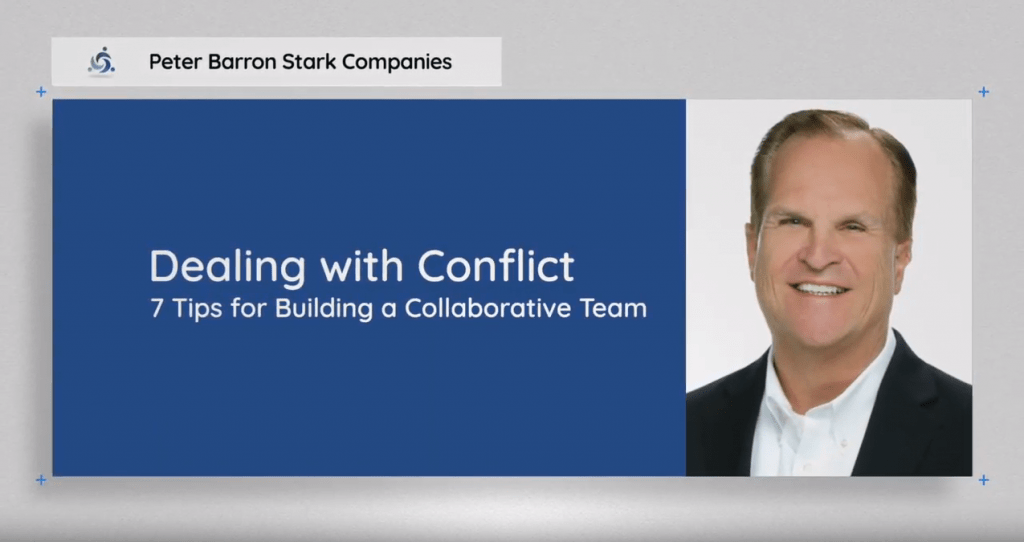Leadership
[Vlog] Dealing with Conflict: 7 Tips for Building a Collaborative Team
I’m advising an executive right now, who has this challenge. She has two employees reporting to her that hate each other’s guts. Now, I may be a little extreme with that expression but I’m pretty confident at telling you this. They don’t like each other, they don’t trust each other, and if given the choice, they don’t want to work with each other. So, how do they deal with that situation? Both of them lobbied their boss one-on-one to try and get the boss to give them what they want which is this. To have roles and responsibilities so clearly defined that these two employees don’t ever have to talk to each other again. Have you ever had two employees, or three employees, who don’t get along and don’t work well as a team? So, what do you do? Here are 7 tips that will help you in building a collaborative team.
#1 – You set really clear expectations with each one of your team members. They need to know that on your team, they’ve been hired because they have a certain level of technical expertise to get the job done. But, that’s only a piece of their job. They also, to be fully qualified for this position, need to work really well as a team member. They’ve got to work collaboratively, they’ve got to be outstanding communicators, and they have to be able to build relationships with all types of people on the team.
#2 – I want to encourage you to keep your head up and pay attention on what is going on between these two employees. Because if you are like me, I don’t really like conflict and all I want to do is pray that these two employees can get it together so that I don’t have to get involved and either facilitate a conflict resolution, or worse, let one of them go. So, keep your head up. Very seldom do these conflicts go away without your involvement.
Here’s #3 – Face reality and lean into conflict sooner not later. Hope is not a good strategy in these types of conflict. Hint. You know, you really need to get along, are not a good strategy in these types of conflict. The sooner you lean in, face reality, and get involved in resolving the conflict, the better it’s going to be.
Here’s step #4 – Meet one-on-one with each employee. Express your expectations. Technically, you need to do a good job. On the teamwork side, you also need to do a good job. Tell each one of them that you are setting up a meeting with both of them in one week. You say, why one week? Because I want them to think about this meeting all week. Set up the meeting and tell them we are going to address three things. Number one, over the last week what has gone well or right in your relationship? What’s worked? Number two, where over this last week are our challenges or opportunities? And, based on those challenges and opportunities, what are our goals and action steps for each one of you over the next week.
And, then here goes, point number #5 – In this meeting, you want to set the next meeting up for one week out. And they are going to go, “What are we going to do?” We are going to do the same thing. We are going to talk about the next week, what goes well or right, where do you have challenges and opportunities and what are our actions and goals for the following week. Now, if you meet one week later, and they did really well, then schedule the next meeting two weeks out. The thing that gets most leaders in trouble, is they meet once and think that this thing is going to be resolved. Very seldom is it ever resolved after one meeting but if both employees know that they have to come back and hear what the other person said went well or right and what the opportunities are, most times they are highly committed to doing a better job as a collaborative team member.
Here goes #7 – What happens if these first six don’t work and they still don’t get along and you’re still spending your day, not working on strategic stuff, working on crap stuff, like two people not getting along. In these situations, I’ve got a great strategic action. I want you to coach them. I want you to counsel them. I want you to actually put them on a PIP. I want you to give them training. I want you to care about them and for some of you, I want you to love them. And, when that doesn’t work, I actually highly recommend you share them with your biggest competitor. You say, why is that a great strategic plan? There is no greater strategic plan than taking your most difficult people and giving them to your competitor. Why does that work? Because now your competitor is taking their time working on crap stuff. Two people, not getting along. You have two new employees who just said this, “Tell me what the goal is and tell me how quickly you want me to achieve this goal and would you be okay if I actually got the goal done working with my cohorts even sooner. That’s your dream. You want employees that every day you walk into the office, and say this, “This brings me joy. I am so blessed.” You deserve it. Go for it.











Leave a reply